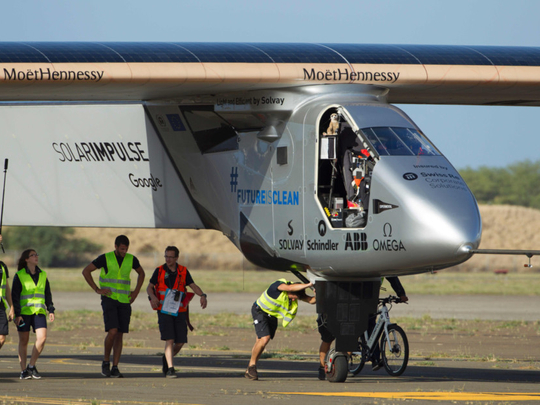
Dubai: The UAE-backed aviation quest by Solar Impulse 2 to circumnavigate the world using only a solar-powered flight will resume in mid-April, says the team leader behind the multi-million-dollar mission.
Solar Impulse 2 is ready once again to champion its next challenge to encircle the remainder of the globe and is expected to end its mission in Abu Dhabi in summer, André Borschberg, CEO and founder, told Gulf News.
“We plan to return sometime this summer to Abu Dhabi but we have no specific deadline regarding the arrival. Once we are in Europe or North Africa we have different strategies to fly to Abu Dhabi depending on the season,” he said.
The aircraft was forced to ditch its mission temporarily after the plane experienced battery damage in its longest and most difficult five-day leg of the round-the-world flight over the Pacific Ocean from Japan to Hawaii where it landed on July 3, 2015.
The eighth leg of the mission logged a 117-hour, 52-minute non-stop flight covering 8,900km, smashing world aviation records for longest single flight ever both for duration and distance as well as for the longest solo flight in history.
While effecting repairs, the plane has remained grounded for eight months in Hawaii waiting to embark on its ninth leg to North America.
The hallmark flight to Hawaii was piloted by Borschberg who said in an exclusive interview that after making repairs to the planes batteries, the team is ready to take to the air once again in a couple of weeks.
Solar Impulse 2 will disembark from Hawaii and plot a track for the United States.
The take-off day is tentatively slated for April 15, pending weather conditions.
The April time window was chosen because days are growing longer, giving Solar Impulse 2 more daylight hours to recharge its batteries while airborne to power the aircraft through the night flights as it flies easterly.
The team expects the ninth leg of the resumed round-the-world flight to the US to take roughly four days and four nights and will be piloted by Solar Impulse 2 chairman Bertrand Piccard given Borschberg completed the first half of the Pacific journey.
Borschberg said the team has every confidence in the world in the Solar Impulse 2 technology and its reliability despite mechanical setbacks that grounded the aircraft last year.
“We had a problem with the batteries — we overheated them. It’s not a problem with the technology, which works very well, but we decided to change them not to not take any risks. So now we are ready to resume the Round-The-World Flight. During our time in Hawaii, our engineers have developed a fail-safe system which should safeguard them from temperature-related glitches in case we have to follow a different mission profile than the one foreseen,” Borschberg said. “It can be controlled from the cockpit and includes a cooling and backup system. In case the cooling system breaks down, the backup one steps in, allowing the pilot to control the opening so that it doesn’t stay completely open, which would cause freezing, or completely closed, leading to another overheating scenario.”
He said the engine housing has been tweaked to include a new air vent allowing for more air flow into the battery’s cooling system.
“The task was to improve the battery system — in particular the insulation and ventilation of the four batteries — so that nothing gets overheated again,” he said.
With new adjustments made to the aircraft, Borschberg said challenges still await Piccard in the cockpit as well as for the entire support team to cross not only the remainder of the Pacific but also the Atlantic Ocean after Solar Impulse 2 completes its crossing of North America.
The physical exertion upon the pilot who must stay awake for long periods of flight time is a major issue as are other health impacts from sustained flying, he said.
“Additionally, being able to stay awake, concentrate and to keep alert is a major human challenge. I did a lot of meditation to learn how to relax and breathe properly during the flight. With my trainer, we developed special exercises in order to keep blood circulation active and relax muscles. These were more postures than exercises, in some way derived from yoga. Above all, however, passion has been the driving force behind this endeavour,” Borschberg said.
Solar Impulse 2
The plane is highly unique with a sizeable wingspan of 72m across — longer than a Boeing 747 — to reduce drag and to house a surface large enough for its 17,248 solar panels. With a maximum altitude of 28,000 feet, the cruising speed is between 50-100 km/h. Solar Impulse 2 has four batteries that power four 17.5 horsepower electric engines.
2004-2009: Start-up financing, design and construction of Solar Impulse 1
2010: First-ever solar-powered day and night flight (André Borshberg)
2011: Special guest at Paris-le-Bourget International Air Show
2012: First intercontinental solar flight across the Mediterranean to Morocco (Bertrand Piccard)
2013: Across America Mission from San Francisco to New York City
2014: Solar Impulse 2 maiden flight
2015: Departure for the Round-The-World Flight from Abu Dhabi
July 3, 2015: First flight of 5 days and 5 nights without fuel over the Pacific from Nagoya, Japan, to Honolulu, Hawaii; and longest solo flight ever achieved (André Borschberg)
April 2016: Round-The-World Flight resumes
Source: Solar Impulse 2












